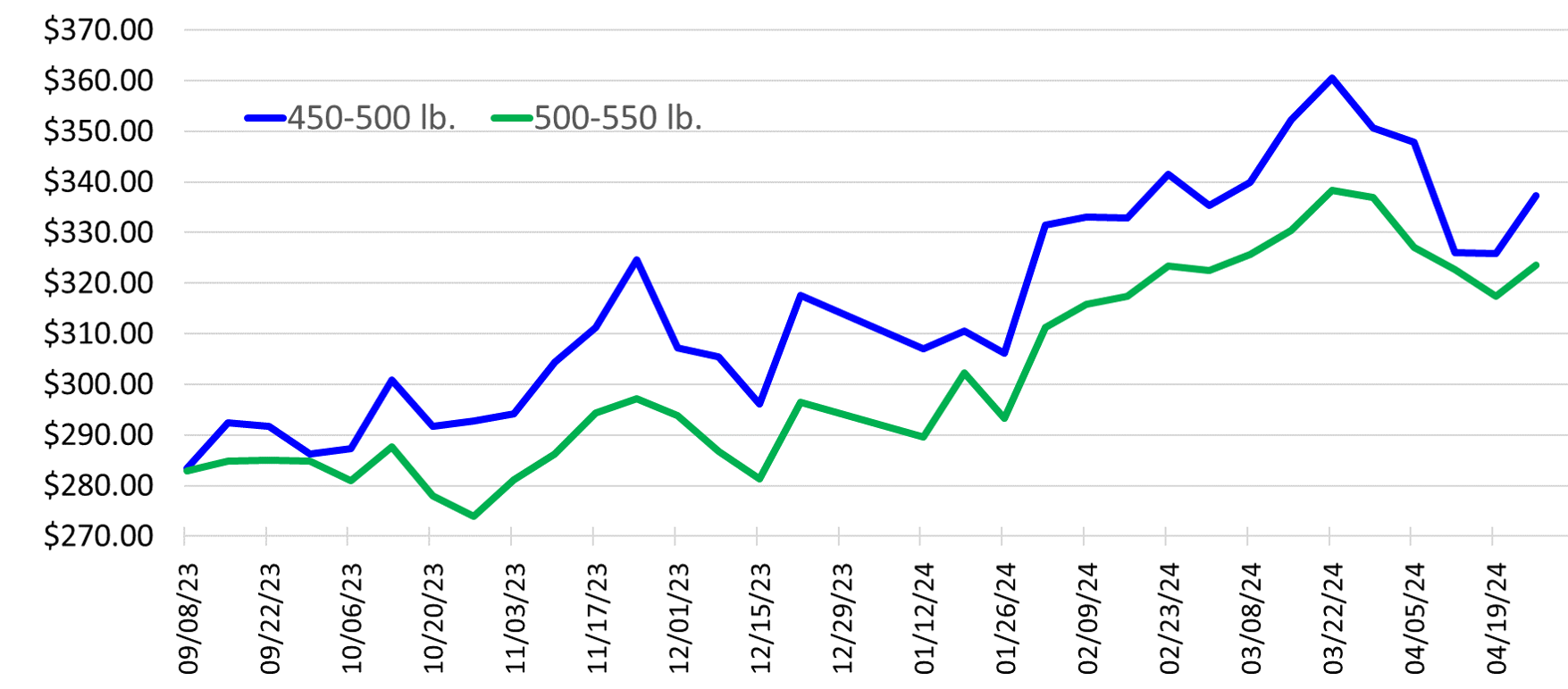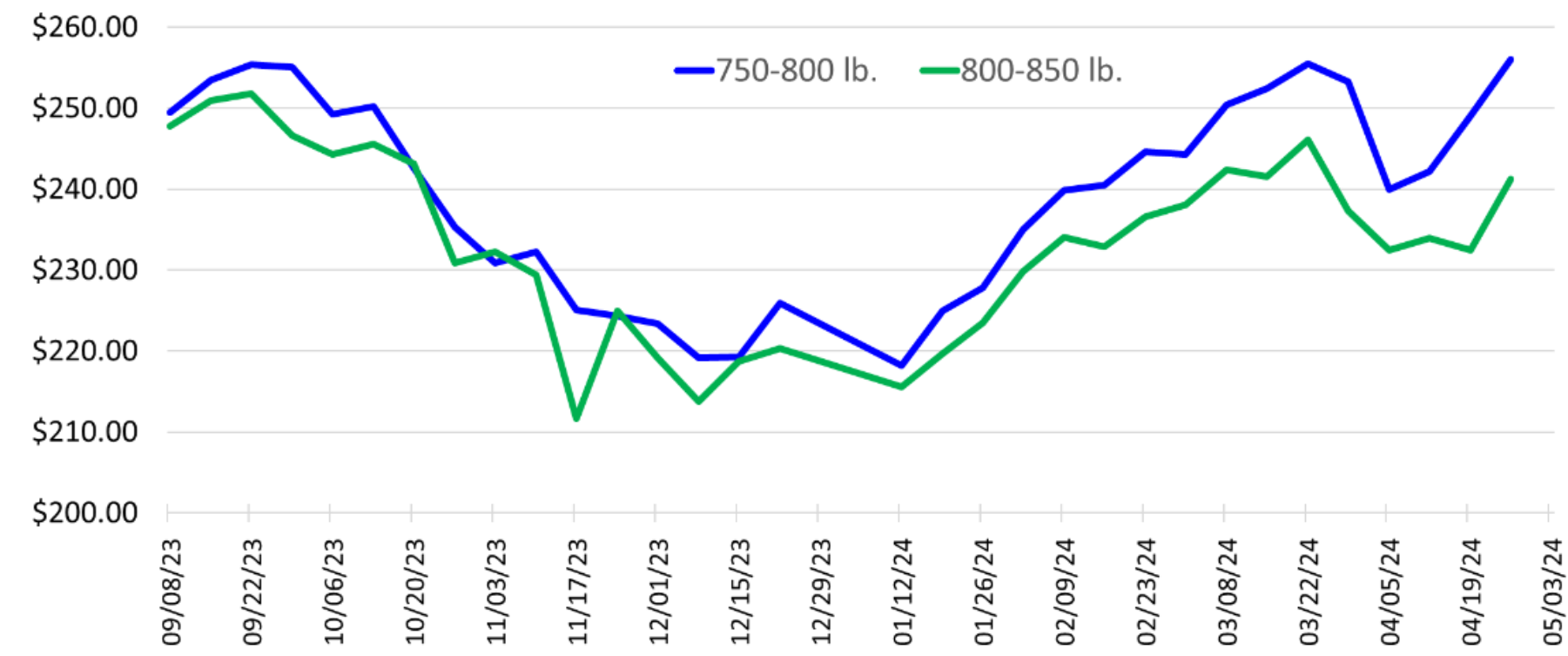Cow-Calf Corner | April 29, 2024
Cattle Markets Back on Track
Derrell S. Peel, Oklahoma State University Extension Livestock Marketing Specialist
A month after cattle markets were roiled by the diagnosis of highly pathogenic avian influenza in dairy cattle, cattle futures and cash markets seem to be mostly recovered. Although there remain questions about some aspects of the disease, including exactly how the disease, now known as Bovine Influenza A virus (BIAV), is spreading between cattle, markets have settled into the knowledge that the disease has relatively minor impacts on cattle, and has no human health implications for meat or pasteurized dairy products. Baring any new surprising information, cattle markets should move on with market fundamentals.
Oklahoma auction prices for steer calves have bounced off the recent lows (Figure 1). Calf prices normally reach a seasonal peak at the end of the first quarter, so steer calf prices may not recover fully to the March highs. However, the strong general uptrend in cattle markets likely means calf prices may move more sideways for a period before moving higher in the later part of the year. Concern about summer grazing conditions could temper stocker demand in the next month or so. In Oklahoma, drought conditions have been reemerging quickly, with the percentage of the state showing abnormally dry conditions or low-level drought increased from about 34 percent in March to nearly 66 percent in the most recent Drought Monitor. However, the outbreak of storms the last weekend of April provided needed moisture in parts of the state, accompanied, unfortunately, by numerous tornados.
Figure 1. A graph showing the price of steers in Oklahoma weighing 450-550 pounds.
Heavyweight feeder cattle prices have bounced more than calf prices buoyed by recovery in Feeder futures and seasonal tendencies for higher prices from now through the middle of the year (Figure 2). Despite the unexpected shocks that have impacted feeder markets, feeder prices are proving to be very resilient. Feedlot demand is strong as feedlots chase limited feeder cattle supplies, spurred on by declining feedlot cost of gain. For all feeder cattle, both calves and big feeders, the highest prices of the year are expected in the fourth quarter.
Figure 2. A graph showing the price of steers in Oklahoma weighing 750-850 pounds.
On January 1, the estimated feeder supply for the U.S. was down 4.2 percent year over year and was the lowest in data available back to 1972. However, the Oklahoma estimated feeder supply on January 1 was up 6.7 percent year over year, reflecting better winter wheat grazing conditions and more stockers on wheat. The weekly volume of feeder cattle in Oklahoma auctions was higher from late February through March, reflecting marketing of cattle off of dual-purpose wheat. Auction volumes have been sharply lower in April but some additional graze-out cattle may be sold in May. Despite the larger feeder supply in the state on January 1, the auction volume of feeder cattle for the year to date in Oklahoma is down 8.7 percent year over year.
Derrell Peel, OSU Extension livestock marketing specialist, says the March cattle on feed report shows a slight decrease in placements from last year on SUNUPTV from April 27, 2024.
Marbling - A Success Story
Mark Z. Johnson, Oklahoma State University Extension Beef Cattle Breeding Specialist
In recent years there has been a significant increase in the percentage of fed cattle in the US reaching the USDA Quality Grade of Prime. This level of quality is driven primarily by the degree of marbling in the ribeye at the 12th-13th rib interface of a beef carcass. Historically speaking, the beef industry routinely saw 1 - 2% of the youngest maturity groups of fed cattle reaching the Prime Quality Grade. It is now normal to see 8 - 10% of the weekly harvest grading Prime. The Quality Grade of Prime indicates the highest level of tenderness, juiciness and flavor of cooked beef. Prime indicates the greatest likelihood of a satisfying eating experience. This is a tremendous success story for the beef industry. It is particularly an example of a job well done by cattle breeders. Marbling is a high heritability trait and selection pressure applied to Marbling EPDs has resulted in an increased genetic potential of the US cattle population to reach this level of quality. There is no doubt that the modern norm of finishing cattle to heavier weights has helped to tap this genetic potential. That being said, the additive genetic potential had to be bred in before it could be tapped.
The past three decades has seen the cattle industry improve the consistency and quality of beef. USDA Quality Grades are the most economically significant factor influencing the value of a beef carcass. Cattlemen and Cattlewomen who retain ownership through finishing have responded to the economic signals in the market place quite successfully. This is a success story in which we should take pride. It also serves as an example of what can be accomplished when we use the modern tools available to make genetic change.
Mark Johnson, OSU Extension beef cattle breeding specialist, explains how to maximize profit potential in your cattle herds on SUNUPTV from April 27, 2024.
The Cost of Bulls in a Stocker Program During the Receiving Period
Paul Beck, Oklahoma State University State Beef Cattle Nutrition Specialist
Intact bulls often receive price discounts at auction markets, with several market survey reports showing price discounts ranging from $5/hundred pounds up to $11.25/hundred pounds. As discussed in an article by Dr. Kellie Raper the Cow-Calf Corner Newsletter the discounts at auction markets send market signals to producers to castrate male calves before marketing. But what do intact bulls cost during receiving and how long do the impacts last?
To answer this, we compiled records from receiving cattle in Mississippi, Arkansas, and Oklahoma with over 1,965 bulls and steers to track performance and health status through receiving before a stocker program. Bulls were castrated by surgery or banding at initial processing. Calves from auction markets are often freshly weaned, unfamiliar with feed and water sources, and transported long distances. Comingling adds social stress and exposure to new diseases. Castration adds surgical stress and pain to these stresses. Calves received as intact bulls were 2.41, 2.25, 2.68, or 2.94-times more likely to have a first, second, third, and fourth treatment, respectively, than calves that were received as steers. Bulls were also 1.16-times more likely to be considered chronically morbid and 2.27-times more likely for BRD mortality than steers. The bulls in this analysis had 65% BRD morbidity, 5% were chronics and had 2.8% death loss compared with steers that had 44% BRD morbidity, 2.4% chronics, and 0.8% death loss. Average performance for calves received as bulls (1.58 lbs/day) was more than 0.5 lbs./day less than steers who gained 2.12 lbs/day during receiving.
Total cost of receiving was $64/head higher for bulls than steers when costs of BRD treatment, chronics, and death losses were included. The reduced gains of bulls during receiving also, reduced the value of bodyweight gain by $36/head compared with steers. We looked at the discounts on bulls to have equal net return at the end of receiving and found that bulls would need to be discounted $22/hundred pounds to be as profitable as steers at the end of receiving.
Recent livestock auction market reports from the Southeast Arkansas Department of Ag Mkt News, April 10, 2024 shows larger discounts for bulls than the above-mentioned market survey reports would suggest with discounts of $16.50/hundred pounds for 400-to-500-pound bulls. This indicates that discounts for bulls is approaching what is necessary to achieve equivalent profits to steers for stocker cattle operations and is a sure signal to producers selling bulls that they are not desired unless deeply discounted.
The series will conclude on May 2nd. This Dairy x Beef Webinar Series covers the management of Dairy Beef crossbreds in the beef production system. There are presentations on research dealing with the effects of sire selection and early life management on finishing performance as well as management and performance of dairy-beef crosses in commercial feeding operations. Experts from across the nation cover recent research and real-world experiences in managing and marketing these unique animal resources.
Blueprint for the Future
Cattlemen's Conference Part Two Registration


